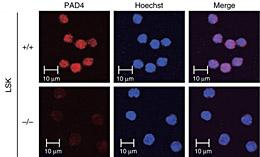Research Abstract
PAD4はc-mycの発現をコントロールすることにより造血多能性細胞の増殖を制御する
PAD4 regulates proliferation of multipotent haematopoietic cells by controlling c-myc expression
2013年5月14日 Nature Communications 4 : 1836 doi: 10.1038/ncomms2862

ペプチジルアルギニンデイミナーゼ4(PAD4)は、ヒストンH3のアルギニン残基をシトルリン残基へ変換することにより、転写調節因子として機能する。PAD4は骨髄細胞において高発現することから造血に関与することが示唆されるが、その明確な寄与は分かっていなかった。本論文では、PAD4がマウス骨髄中のlineage − Sca-1+ c-Kit+(LSK)細胞において、強く発現していることを示した。また、PAD4はc-myc遺伝子上流においてヒストンH3をシトルリン化することによりc-mycの発現をコントロールすることを示唆した。さらに、PAD4はLEF1とヒストン脱アセチル化酵素1と共にc-myc遺伝子の上流領域に結合していた。PAD4欠損マウスでは、LSK細胞、特に多能性前駆細胞の増殖能や細胞数が、野生型のマウスと比較して増加していた。以上のことから、PAD4はc-mycの発現をコントロールすることにより、骨髄の多能性前駆細胞の増殖を制御していることを強く示唆した。
中島 克彦1, 新井 郷子1, 鈴木 亜香里2, 成相 裕子3, 浦野 健3, 中山 学4, 小原 収4, 山村 研一5, 山本 一彦2 & 宮崎 徹1
- 東京大学 大学院医学系研究科 疾患生命工学センター
- 東京大学 大学院医学系研究科 アレルギーリウマチ学
- 島根大学 医学部 病態生化学講座
- かずさDNA研究所 ヒトゲノム研究部
- 熊本大学 生命資源研究・支援センター 疾患モデル分野
Peptidylarginine deiminase 4 (PAD4) functions as a transcriptional coregulator by catalyzing the conversion of histone H3 arginine residues to citrulline residues. Although the high level of PAD4 expression in bone marrow cells suggests its involvement in haematopoiesis, its precise contribution remains unclear. Here we show that PAD4, which is highly expressed in lineage− Sca-1+ c-Kit+ (LSK) cells of mouse bone marrow compared with other progenitor cells, controls c-myc expression by catalyzing the citrullination of histone H3 on its promoter. Furthermore, PAD4 is associated with lymphoid enhancer-binding factor 1 and histone deacetylase 1 at the upstream region of the c-myc gene. Supporting these findings, LSK cells, especially multipotent progenitors, in PAD4-deficient mice show increased proliferation in a cell-autonomous fashion compared with those in wild-type mice. Together, our results strongly suggest that PAD4 regulates the proliferation of multipotent progenitors in the bone marrow by controlling c-myc expression.

